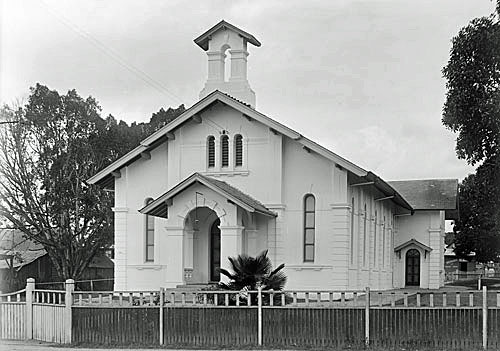
Central Congregation Church, Ipswich (1890s?)
[Photograph from Whitehead Collection,
courtesy of Picture Ipswich, Ipswich City Council]

Central Congregation Church, Ipswich (1890s?)
[Photograph from Whitehead Collection,
courtesy of Picture Ipswich, Ipswich City Council]
Historical and Technical Documentation by Geoffrey Cox1
© OHTA, 2006, 2012, 2013 (last updated May 2013)
Ipswich is located on the Bremer River, 40km south-west of Brisbane, and is the oldest provincial city in Queensland. Originally named 'Limestone' it was first settled in 1827 as a convict settlement to work the limestone deposits in the nearby hills. Following the opening of the area for free settlement in 1842, it was renamed 'Ipswich' in 1843. Enjoying a strategic position at the intersection of routes to the Darling Downs and the Upper Brisbane Valley, it vied for a time with Brisbane as the potential capital of Queensland, and it remains a major industrial centre.
The Congregational Church in Ipswich was formed officially on 2 June 1854 as a union of necessity between the Baptist and Independent faiths due to small numbers of each in the pioneer town of Ipswich. The Ipswich Congregational Church was the first Congregational parish in Queensland and it soon expanded throughout the state in the later decades of the nineteenth century. The first Congregational Church building in Ipswich was a timber building opened in 1855. It was built by Samuel Shenton, a building contractor and a founding member of the Congregational Church, who later practiced as an architect.2
In 1870 a new church was constructed adjacent to the old church. Built in the Georgian style, with a porch and a simple belfry over the entrance in Brisbane Street, it was designed by the architect, F.D.G. Stanley (at this time a clerk of works in the Office of the Colonial Architect), who had won a competition for its design in 1869.3 The new church survived disastrous floods in 1887 and 1893, but its life as a centre for worship did not finally come to an end until 1953, when the interior was destroyed in a devastating fire. The building was used thereafter as a motor repair workshop, and the congregation moved to a new church in East Street in 1958. The old building in Brisbane Street finally succumbed to sledge hammers around 1972-73 to make way for a shopping complex.4
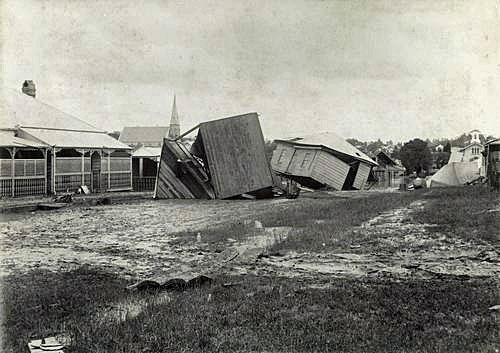
Wreckage caused by floods at the Congregational Church, Ipswich, 1893
[Photograph: John Oxley Library, State Library of Queensland]
The earliest references to the pipe organ in this church date from November and December 1881, when Mr A.H. Barlow of Ipswich offered to sell to the church an organ recently built for him in Melbourne. The room for which it had been intended in his residence had reportedly proven too small, and Barlow was prepared to offer the instrument to the church for the cost price of £300.5 The name of the Melbourne organ builder is not recorded in any of the correspondence from Barlow to the church or in the church records. By August 1882, however, by which time the instrument had been installed in the church, the builder is clearly identified as Alfred Fuller of Kew:
THE NEW ORGAN AT THE CONGREGATIONAL CHURCH
The Congregationalists in this town are to be congratulated upon the acquisition of a new and powerful organ designed by and built for a gentleman in this town by Mr. Alfred Fuller, Main-road, Kew, Melbourne, but disposed of by the owner consequent upon the great volume of the tone being found unsuitable to a private house, and necessitating the erection of a very large building to give effect to the various stops.
We understand that the organ will be "opened" on Thursday evening next, the 24th instant, with a grand concert of sacred music under the leadership of Mr J. J. Wells, the organist of the Church: and those of our readers who wish to hear one of the finest instruments in the colony should attend on the occasion.
The organ contains in all 698 speaking pipes, besides the modern invention of the "octave coupler," by which 300 pipes are practicably doubled, so that full number of pipes under control of the organist is not far short of 1000; and the complicated mechanism by which these are kept under perfect control is really very interesting to those who take the trouble to understand it.
Technically the organ is as follows:-
1. Two manuals (or rows of keys for the fingers), CC to G in alto, 56 notes.
2. Independent pedal organ (in which the notes are played by the feet of the performer), CCC to F, 30 notes.
1.
2.
3.
4.
5.
6.
7.
8.
Dulciana, metal C
Stopped diapason [bass], wood CC
Clarabella, wood [C]
Principal, metal CC
Flute, wood CC
Fifteenth, metal CC
Cremona, metal C
...
...
...
...
...
...
...
...
8ft.
8ft.
8ft.
4ft.
4ft.
2ft.
8ft.
44
[12]
[44]
56
56
56
44
___
368
1.
2.
3.
4.
5.
6.
7.
Lieblich gedackt, wood [C]
Stopped bass, wood CC
Bell gamba, or keraulophon, metal C
Gemshorn, metal C
Harmonic flute, metal CC
Hautboy, metal C
...
...
...
...
...
...
...
8ft.
8ft.
8ft.
4ft.
4ft.
8ft.
[44]
[12]
44
56
56
44
___
300
1.
...
Total pipes 698, of which the 300 in swell are practically doubled by an octave coupler which throws down automatically the octave of each note touched by the finger.
There are also couplers to connect the pedals to great, pedals to swell, and great to swell, beside three "composition" pedals to the great organ which throw into action certain combinations of stops by a mere touch of the foot of the player.
The hautboy and cremona are, of course, "reed" stops, which, for the benefit of the uninitiated, we may say are in fact a combination of the organ and harmonium, having the pipes of the former and the "reed" or vibrator of the latter. For solo passages these reeds are very grand, and were heard to much advantage in the house of the former owner of the organ; but, as they take some time to "settle in tune," it is possible that they may not be in perfect trim for a few weeks.
The "Lieblich gedackt," which our German friends will translate for themselves as the "lovely thought"[sic] is an especial feature in this organ, as is also the bell gamba or keraulophon; and the wooden flute of the great organ is an almost ludicrous imitation of that homely instrument of the home and family. Being erected in a place of worship, the powers of this instrument can never, perhaps, be heard to their fullest extent in orchestral music, and those who were privileged to hear "Les Cloches de Corneville" and "The Pirates of Penzance" music upon it have probably an advantage over those who will hear it only in sacred music; but the Church is fortunate in securing such an instrument at the very moderate cost of about £350, and we trust that the opening concert in aid of the fund for the purchase of the organ will be a great success.6
The circumstances surrounding the instrument were described also in the following account, which appeared in the Congregational Year Book of 1883. The reference here to 'twenty-two stops' presumably included 4 couplers and 3 composition pedals in addition to the 15 speaking stops (excluding the stopped bass):
The New Organ
During the past year a beautifully-toned two-manual organ, with independent pedals and three composition pedals and octave coupler with twenty-two stops [sic], including two reed stops and Venetian swell and all modern improvements, has been added to the church.
This organ was built in Melbourne to the order of A. H. Barlow, Esq., who, finding it much too powerful for his large room, although built expressly for the purpose, desired to part with it.
Mr Barlow was very anxious that the organ should remain in Ipswich, and accordingly, offered it on extremely liberal terms. Ultimately, the church purchased the organ . . . The price of the organ was £300 . . . The casing of the organ and refixing of seats absorbed about £31 . . .
The position of the organ and style of casing was carried out by a special committee, consisting of the Deacons and Messrs Shenton, Macgregor, W. Hancock & Wells. . . . The organist, Mr Wells, is allowed to take pupils, not exceeding five in number, who must practice in his presence only, and who can only be admitted as pupils after approval by the Deacons.
In conclusion, it may safely be affirmed that the possession of this beautiful instrument is at once an ornament to the church and a help to our service of song; and though some might have thought at first that we did not need it, yet few would now part with it.
Enoch Bostock
Treasurer of organ fund.7
Earlier conjecture surrounding the identity of the organ builder was based on a Tariff Report of the time stating that Fuller had built an organ for Queensland, together with the fact that Barlow's instrument had been built in Melbourne. This nevertheless lead to a number of unqualified statements behind which conjecture had become confused with fact.8 It is fortunate that the above account puts the matter to rest and confirms that Fuller was the builder of this instrument.
The opening concert on Thursday 24 August 1882 was advertised in the local press,9 and described soon afterwards as follows:
A very large audience assembled in the Congregational Church last Thursday evening on the occasion of the sacred concert given in connection with the "opening" of the new organ which the congregation have had the good fortune to secure. The organ is undoubtedly one of the finest instruments in the colony, and the members of the Church have every reason to be proud of such a valuable acquisition. After a few appropriate remarks from Rev. Mr. Greenwood – in which he expressed his satisfaction that the Church had become possessed of so fine an instrument, and remarked that it was yet very much like a new piece of furniture, and had not its Sunday clothes on – the concert was opened by Mr. J. J. Wells, the organist, who played the overture to "Zampa" in fine style, and at the conclusion was rewarded with a hearty round of applause from the audience. Then followed a chorus, "Father, reigning in thy glory," which was satisfactorily rendered by the choir, amongst whom were several persons from other religious denominations. A solo, "Rest," was very nicely sung by a lady who has always been a great favourite with her audiences, and its rendition was highly applauded. Amongst the most noticeable features in the first part was "He wipes the tear from every eye," which was sung by a young lady in a most praiseworthy manner, and elicited well-merited applause. The chorus "Sanctus," (Twelfth Mass) was well rendered by the choir. The second part commenced by Mr. Wells playing a "March" on the organ with good effect. The "Pro Piccalis" (from Rossini's "Stabat Mater") was sung by a gentleman who unfortunately is not heard often enough at our Music Society's concerts: his rendering of this grand composition was very warmly received. "Hark, I hear an angel sing" by a lady, and "Resignation," by a gentleman, were both well rendered, the latter especially, as an encore was demanded. The anthem "Holy is the Lord our God,"and the chorus "O sing to the Lord," were each well given by the choir in this part. A verse of the "National Anthem" brought a very pleasant evening to a close. The proceeds of the concert, which are to be devoted to the organ fund, should amount to a good round sum. The concert, on the whole, was not so successful, in one or two respects, as could have been wished; but considering that the organ has just been erected, and that the choir had very little time for practice, perfection was not to be expected. When the instrument has, if we may so express it, settled down to its work, we shall probably see a marked and pleasing improvement. Mr. James Haldane, of Brisbane, was the contractor for the erection of the organ, and he seems to have done his work in a skilful and finished style, and in a manner reflecting the greatest credit upon him. The encasing of the instrument was entrusted to Mr Alexander Macgregor, builder and contractor, of this town, and we need not add that in the carrying out of his portion of the work he has left nothing to be desired.10
The original position of the organ in the church is not clear, but the choir was described at this time as occupying 'three seats in front of the organ as well as the two side seats each side of the organist.'11 A water motor was ordered in September 1882, and at the same time Barlow was refunded the sum of £34.5.0 expended by him for his part in erecting the organ.12
Fuller's instrument went on to survive several catastrophic events: In the great flood of January 1887, the water is reported to have risen several feet inside the church and 'the lower part of the organ was destroyed.'13 It appears that the organ was rebuilt and enlarged at this time by the Queensland [Piano, Organ and] Music Warehouse Company, for whom B.B. Whitehouse was head tuner:
The Queensland Music Warehouse Company are engaged in rebuilding and enlarging the organ in the Congregational Chapel, Ipswich, and when finished it will contain two complete manuals and pedal organ, making it one of the most complete instruments in the town.14
Immediately prior to another major flood that submerged much of Ipswich in February 1893, the organ was removed to storage in the upper hall of the Building Society, but the water again rose sufficiently high to cause significant damage.15 The question of repairs remained unresolved until 1896, when it was agreed that the organ be repaired by Mr Whitehouse of Brisbane at a cost of £65. Missing pipes were to be supplied and the organ was to be fixed 'in the western wing.'16 This suggests that it may originally have been located in a central position behind the pulpit.
Yet another flood occurred in January 1898, but on this occasion the organ was removed in good time and re-erected in March that year.17 The organ was again removed in March 1908 to avoid flood damage:
THE BREMER IN FLOOD
LITTLE DAMAGE. IPSWICH, March 15.The Bremer River commenced to rise early yesterday morning. . . and was rising 3ft. per hour. . . . At the Central Congregational Church the organ and fittings were removed, but the water only just got into the church grounds.18
The organ was presumably not damaged at this time, but there was correspondence in April 1908 between the organist of the church, Mr Sydney May, and George Fincham of Melbourne concerning a proposal to rebuild the organ. The original soundboards, bellows and trackers were to be retained, but new action, keyboards, pedals and organ stool were to be supplied.19 It appears that this proposal was not carried out. Notes from the Church and Deacon Minutes record that an electric blower was supplied in 1919 at a cost of £65, replacing an earlier water motor.20
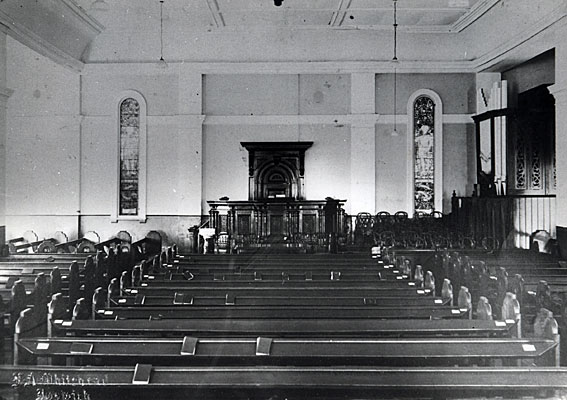
The interior of the Central Congregational Church, Ipswich, shortly before 1935,
showing the 1881 Alfred Fuller organ, already enlarged in 1887
[Photograph by J.A. Whitehead, Ipswich, supplied by Whitehouse Bros, c.1973]
There were discussions concerning a new church and new organ from at least 1921, but by 1934 it was decided that the existing church should be renovated and a new organ installed.21 The organ contract was let to Whitehouse Bros of Brisbane, and the specification was drawn up by the church organist, Mr Francis Edward Willesden. The work was completed on 11 July 1935 at a total cost of £1,556, and to a specification that had been agreed on 9 October 1934.22 An opening recital and concert was given on Wednesday 24 July, 1935, including organ solos played by Mr Willesden, along with items for choir, and for violin with organ.23
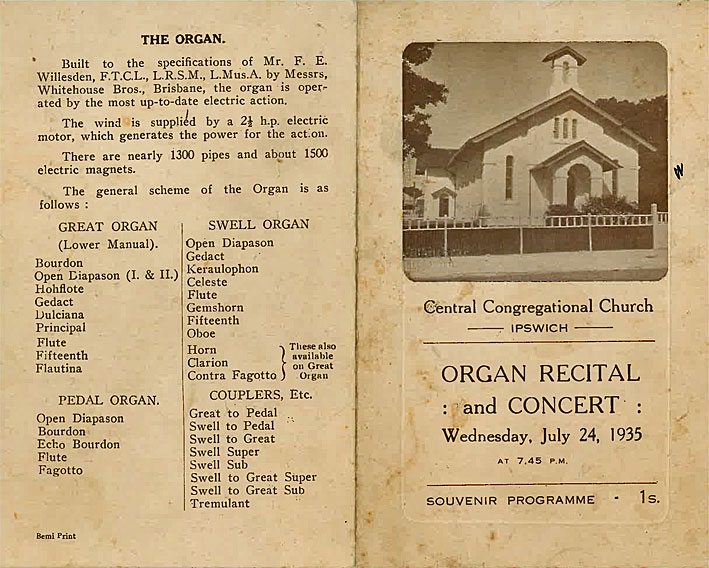
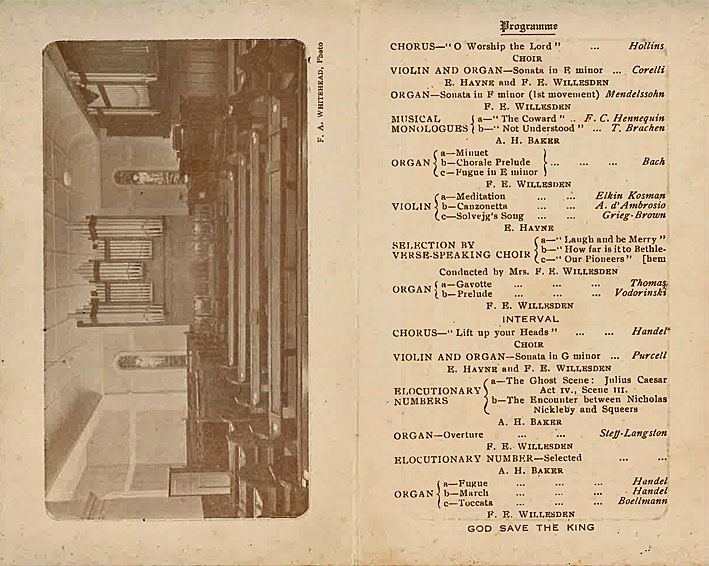
Opening recital programme on the rebuilt and enlarged organ
at the Central Congregational Church, Ipswich, 24 July 1935
[supplied by David Vann]
There was a rumour at one time that the old organ from the Central Congregational Church was now at St Peter's Anglican Church, Southport,24 but this has no foundation and appears to result from confusion with the old organ at St Stephen's Presbyterian Church, Ipswich.25 The original Alfred Fuller organ contained 14 speaking stops, and was enlarged in 1887. It is likely that most if not all of the old pipework was retained in the rebuilt organ. One report states in particular that 'the pipes of the old organ form the swell organ of the new,'26 and the records of Whitehouse Bros refer to 'removing Swell Organ to Transept' and 'removing old organ bass pipes to swell side.'27
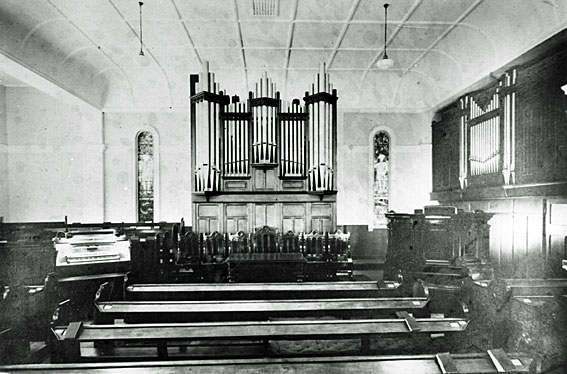
The interior of the Central Congregational Church, Ipswich, after 1935
showing the organ electrified, enlarged and rebuilt by Whitehouse Bros
[Photograph by J.A. Whitehead, Ipswich, supplied by Whitehouse Bros, c.1973]
The 1935 Swell organ was located in the transept, while the Great and Pedal were placed in the centre in a new case of waxed and polished Queensland silky oak. A new detached console, also of silky oak, was placed on the opposite side to the Swell organ, featuring stop-tabs arranged in a semi-circle in the style of a theatre organ, and modern combination pistons.28 The old central pulpit was reduced in size at this time and moved to one side of the church.29
This organ was very significant in the Whitehouse opus at the time, not least because it was the firm's first major instrument to use electro-pneumatic action. Following their part in rebuilding the Brisbane City Hall organ in 1927-29, Whitehouse Bros had built a number of smaller extension organs in the period 1932-34, and in March 1935 the relatively small electro-pneumatic organ for the Catholic Apostolic Church, South Brisbane. A newspaper report from around the time of the inauguration of the Ipswich organ described it as 'an electric organ acclaimed to be the largest and most up-to-date two manual instrument yet erected in Queensland,' and it was also noted that this was the eightieth organ the firm had built in the 40 years that the older Mr Whitehouse had been in Queensland.30
| GREAT Bourdon Open Diapason No 1 Open Diapason No 2 Hohl Flute Gedact Dulciana Principal Flute Fifteenth Flautina Fagotto [Swell] Horn [Swell] Clarion [Swell] SWELL Open Diapason Gedact Keraulophon Celeste Flute Gemshorn Fifteenth Fagotto Horn Oboe Clarion PEDAL Open Diapason Bourdon Echo Bourdon Flute Fagotto COUPLERS Great to Pedal Swell to Pedal Swell to Great Swell Super Swell Sub Swell to Great Super Swell to Great Sub |
16 8 8 8 8 8 4 4 2 2 16 8 4 8 8 8 8 4 4 2 16 8 8 4 16 16 16 8 16 |
A A B B B B B B B |
Swell tremulant
Electro-pneumatic action
Detached stopkey console
3 thumb pistons to Great & Pedal
3 toe pistons to Geat & Pedal
3 thumb pistons to Swell
1 Full-Swell toe piston.31
Had this organ survived, it might well have been comparable with the Whitehouse organ of 1942 for St Mary's Cathedral in Sydney, which was two stops smaller.
But this was not to be: The interior of the Ipswich church was irrevocably damaged by fire in February 1953.32 The Swell organ reportedly escaped damage and £450 was offered for it.33 The remnants of the organ were removed by Whitehouse Bros in September 1953 at a cost of £104.5.6.34 It appears that what remained of the instrument was broken up: The console and Swell soundboard found their way to the rebuilt Lewis organ for All Saints' Anglican Church, Wickham Terrace, Brisbane in 1957, and the bottom (16ft) octave of the Swell reed unit was incorporated in 1963 into the organ at Holy Family Catholic Church, Indooroopilly.35
___________________________________________________________________
1 An earlier version of the historical documentation presented here for the 1881 organ by Alfred Fuller appeared in 2006 as: Geoffrey Cox, 'Documenting Alfred Fuller in Queensland,' OHTA News, vol. 30, no. 1 (January 2006), pp. 18-21.
2 Queensland Heritage Council, Queensland Heritage Register, location 600594; Donald Watson & Judith McKay, Queensland Architects of the 19th Century: A Biographical Dictionary (Brisbane: Queensland Museum, 1994), p. 159.
3 Watson & McKay, op. cit., pp. 166-69.
4 The Queensland Times (undated clipping, c. 1972-73), supplied to G. Cox by Kevin Whitehouse, c.1974.
5 Letters from A.H. Barlow to church authorities (14 Nov., 7, 22 & 24 Dec. 1881, reproduced in Thomas Appleton, 'The Pipe Organs of Central Ipswich,' The Organ Voice, vol. 25, no. 1 (March 1999), pp. 18-20; Church and Deacon Minutes (29 December 1881), cited by Miss Viva Cribb, and supplied to G. Cox by Mr Bryan Capern, 1974.
6 The Queensland Times (19 August 1882) p. 3. NOTE that square-bracketed details in the specification have been amended by the present author to provide a logical specification, and to account for the reported 'total' number of pipes.
7 Congregational Year Book (1883), cited by Miss Viva Cribb, and supplied to G. Cox by Mr Bryan Capern, 1974.
8 Geoffrey Cox, 'Documenting Alfred Fuller in Queensland,' op. cit.
9 The Queensland Times (12 August 1882), p. 2.
10 The Queensland Times (26 August 1882), p. 3.
11 Church and Deacon Minutes (15 August 1882), cited by Miss Viva Cribb, op. cit.
12 Church and Deacon Minutes (4 September 1882), cited by Miss Viva Cribb, op. cit.
13 George Wight, Congregational Independency: Its Introduction to Queensland, with Reminiscences of the Churches and Photographs of Pioneers (c.1887), cited by David Vann in personal communication to G. Cox, 1974.
14 The Brisbane Courier (7 January 1887), p. 6.
15 Church and Deacon Minutes (4 February 1893), cited by Miss Viva Cribb, op. cit.
16 Church and Deacon Minutes (8 April 1896), cited by Miss Viva Cribb, op. cit.
17 Church and Deacon Minutes (2 March 1898), cited by Miss Viva Cribb, op. cit.
18 The Brisbane Courier (16 March 1908), p. 6; The Queenslander (21 March 1908), p. 33.
19 George Fincham Letter Book 21, p. 830 (2 April 1908); p. 859 (21 April 1908) (State Library of Victoria).
20 Church and Deacon Minutes (3 December 1919, 1 November 1922), cited by Miss Viva Cribb, op. cit.
21 Church and Deacon Minutes (29 August 1934), cited by Miss Viva Cribb, op. cit.
22 Whitehouse Bros Ledger (1922-1940), p. 449.
23 Programme of Organ Recital and Concert, Central Congregational Church, Ipswich, 24 July 1935, supplied to G. Cox by Kevin Whitehouse, 1974, and by David Vann, 2012; The Queensland Times (24 July 1935), cited in Appleton, op. cit., p. 18.
24 Personal communication from Miss Eva Tongue, who was a pupil of the late Sydney May (Organist at Central Congregational Church before the 1920s), supplied to G. Cox via Mr Bryan Capern, 1974.
25 There was a corresponding rumour at Southport that the organ there came from St Mary's, Ipswich.
26 Central Congregational Church, Ipswich: One Hundred Years 1853-1953 (Ipswich, 1953), cited by David Vann, 1974.
27 Whitehouse Bros Ledger (1922-1940), p. 449.
28 Unidentified newspaper report of 1935 supplied to G. Cox by Kevin Whitehouse, 1974.
29 Central Congregational Church, Ipswich: One Hundred Years 1853-1953 (Ipswich, 1953), cited by David Vann, 1974.
30 Unidentified newspaper report of 1935 supplied to G. Cox by Kevin Whitehouse, 1974.
31 Collected Organ Specifications of Bernie Brohan (c.1952); Programme of Organ Recital and Concert, Central Congregational Church, Ipswich, 24 July 1935; and unidentified newspaper report of 1935 supplied to G. Cox by Kevin Whitehouse, 1974.
32 The Queensland Times (17 February 1953), cited in Appleton, op. cit., p. 18.
33 Church Minutes (18 February & 14 July 1953), cited in Appleton, op, cit., p. 17.
34 Whitehouse Bros Ledger (1940-1954), p. 150.
35 Personal communication to G. Cox from Mr J.H. Whitehouse, June 1974.